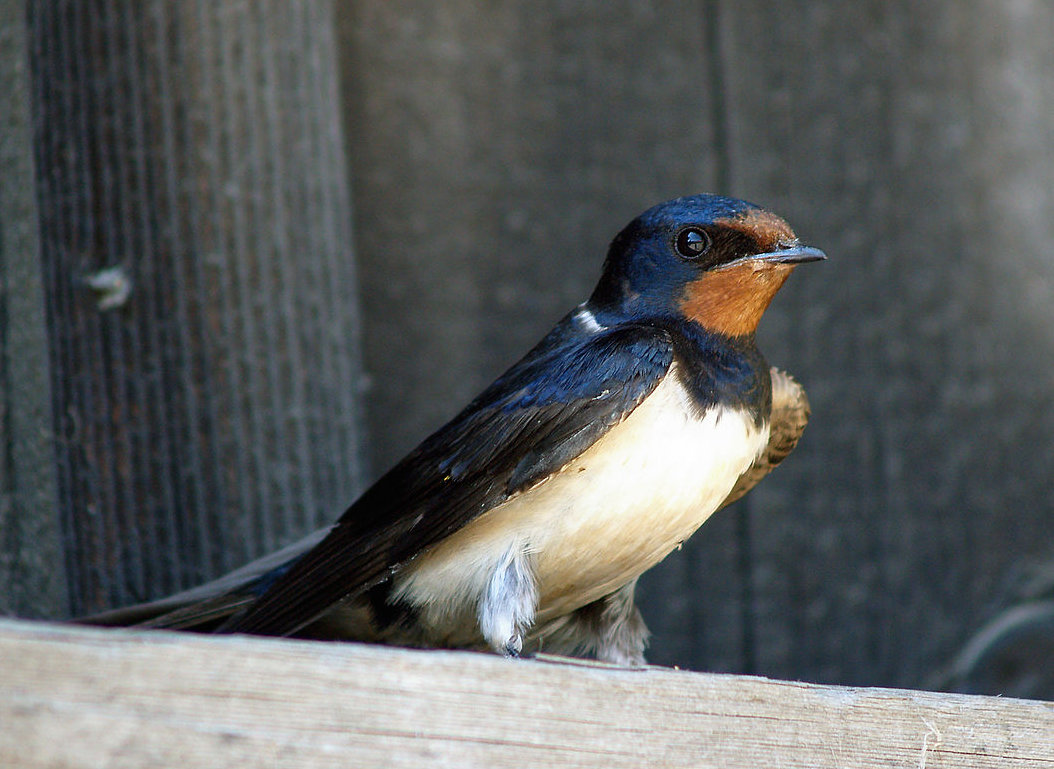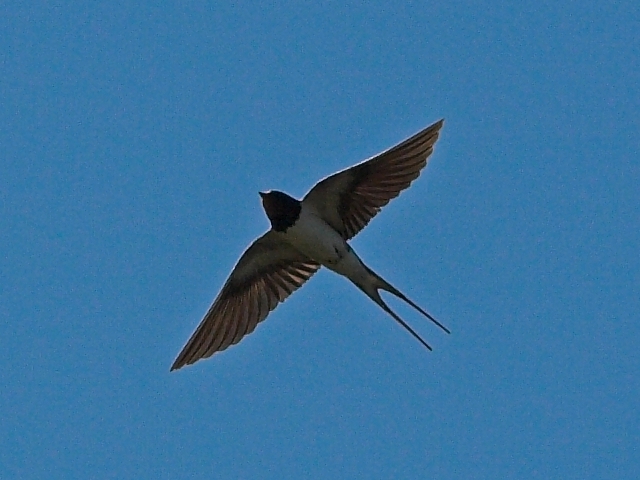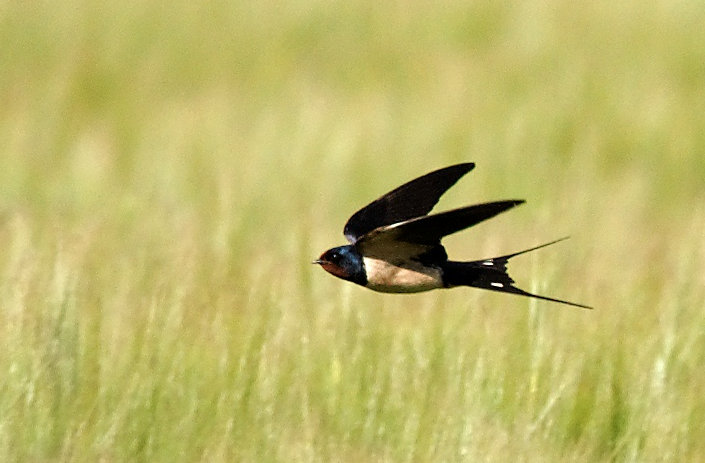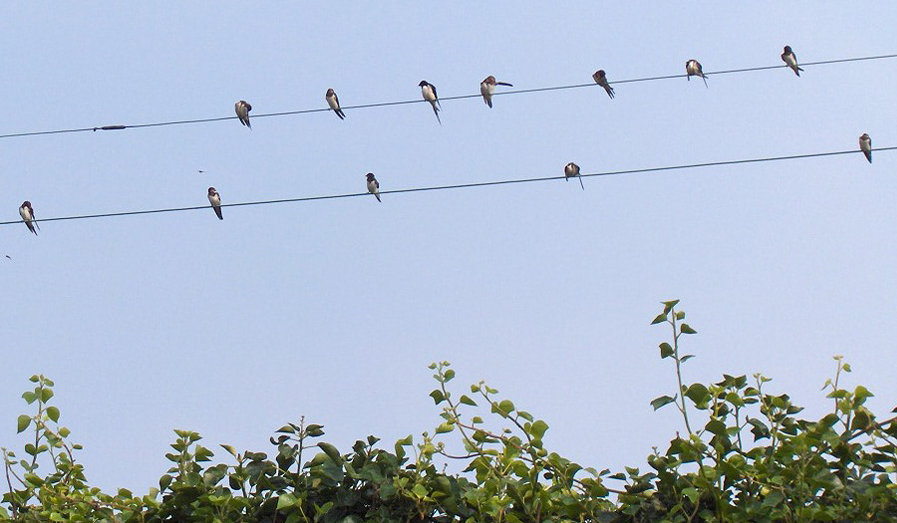Garden Wildlife
Garden Wildlife






What do they eat?
Swallows are specialist at catching flying insects chased on the wing. Flies are particularly important, and they often catch them over water bodies, as bats do at dusk.
Where do they breed?
Swallows like nesting in open barns, on rafters or ledges, building an open nest of straw lined with mud. They have two, occasionally three broods of up to 5 eggs between May and September, while food supplies keep up. They often return to the same nest in successive years.
What do they do?
Swallow seem endlessly busy, darting and swooping through the air catching small flying insects, sometimes up high, more often close to the ground or over water. They tend to gather in small flocks on telegraph wires before starting their migration back to southern Africa several thousand miles away.
Swallow Hirundo rustica
Swallows are popular summer visitors – indeed we say “One swallow doesn’t make a summer”. However the French say “Une hirondelle ne fait pas le printemps” – or “One swallow doesn’t make a spring” because further south they arrive a bit earlier. They are reported from only 6% of gardens, and generally prefer more rural than urban habitats
What do they look like?
Up close, swallows are very handsome birds, with a glossy blue-black back, white breast and underparts, and a dark red forehead and throat. Males and females are alike, juveniles much duller.
You are most likely to see them flying overhead or hunting over a field, and then you can see the characteristic long tail streamers, which mark the swallow out from similar species. Swallows are about 18cm long, but much of that is tail.
What do they sound like?
Song is a rapid outpouring of warbling and twittering that can sound as if they are gossiping. Their flight call is a sharp “tswee”, and nestlings and juveniles are very noisy with an impatient double “wik-wik” call.
Song Flight call Juveniles begging
Dominique Guillerme, XC699397. Accessible at www.xeno-canto.org/699397.
Carlos W., XC704102. Accessible at www.xeno-canto.org/704102.
Carlos W., XC704111. Accessible at www.xeno-canto.org/704111.
How are they doing?
Swallows are currently losing ground, having built up numbers between 1990 and 2010, but there has been a drop back to 1990 levels since then. In 2016 there were 705,000 territories, but there must be fewer now.
Finding out more:
BTO profile on swallow
RSPB profile on swallow
Page written and compiled by Steve Head
Swallow Hirundo rustica
Swallows are popular summer visitors – indeed we say “One swallow doesn’t make a summer”. However the French say “Une hirondelle ne fait pas le printemps” – or “One swallow doesn’t make a spring” because further south they arrive a bit earlier. They are reported from only 6% of gardens, and generally prefer more rural than urban habitats.


What do they look like?
Up close, swallows are very handsome birds, with a glossy blue-black back, white breast and underparts, and a dark red forehead and throat. Males and females are alike, juveniles much duller.

You are most likely to see them flying overhead or hunting over a field, and then you can see the characteristic long tail streamers, which mark the swallow out from similar species. Swallows are about 18cm long, but much of that is tail.
What do they sound like?
Song is a rapid outpouring of warbling and twittering that can sound as if they are gossiping. Their flight call is a sharp “tswee”, and nestlings and juveniles are very noisy with an impatient double “wik-wik” call.
Song Flight call Juveniles begging
What do they eat?
Swallows are specialist at catching flying insects chased on the wing. Flies are particularly important, and they often catch them over water bodies, as bats do at dusk.
Where do they breed?
Swallows like nesting in open barns, on rafters or ledges, building an open nest of straw lined with mud. They have two, occasionally three broods of up to 5 eggs between May and September, while food supplies keep up. They often return to the same nest in successive years.
What do they do?
Swallow seem endlessly busy, darting and swooping through the air catching small flying insects, sometimes up high, more often close to the ground or over water. They tend to gather in small flocks on telegraph wires before starting their migration back to southern Africa several thousand miles away.
How are they doing?
Swallows are currently losing ground, having built up numbers between 1990 and 2010, but there has been a drop back to 1990 levels since then. In 2016 there were 705,000 territories, but there must be fewer now.
Finding out more:
Page written and compiled by Steve Head
























